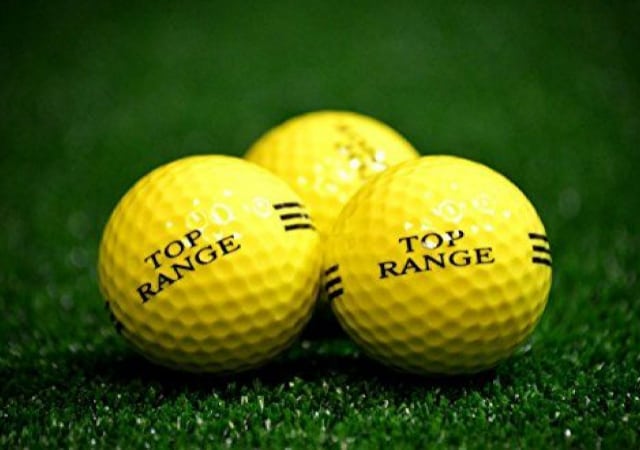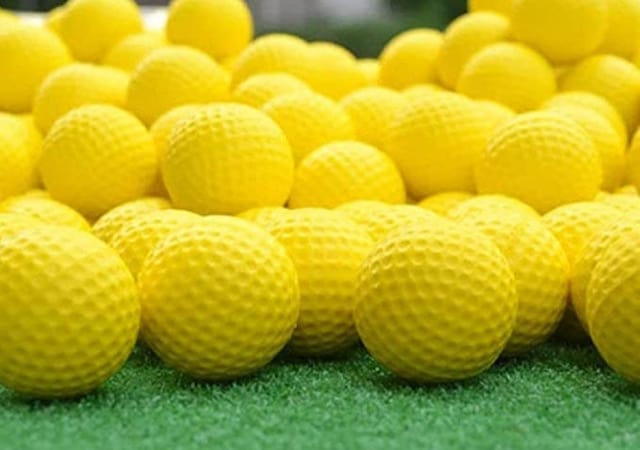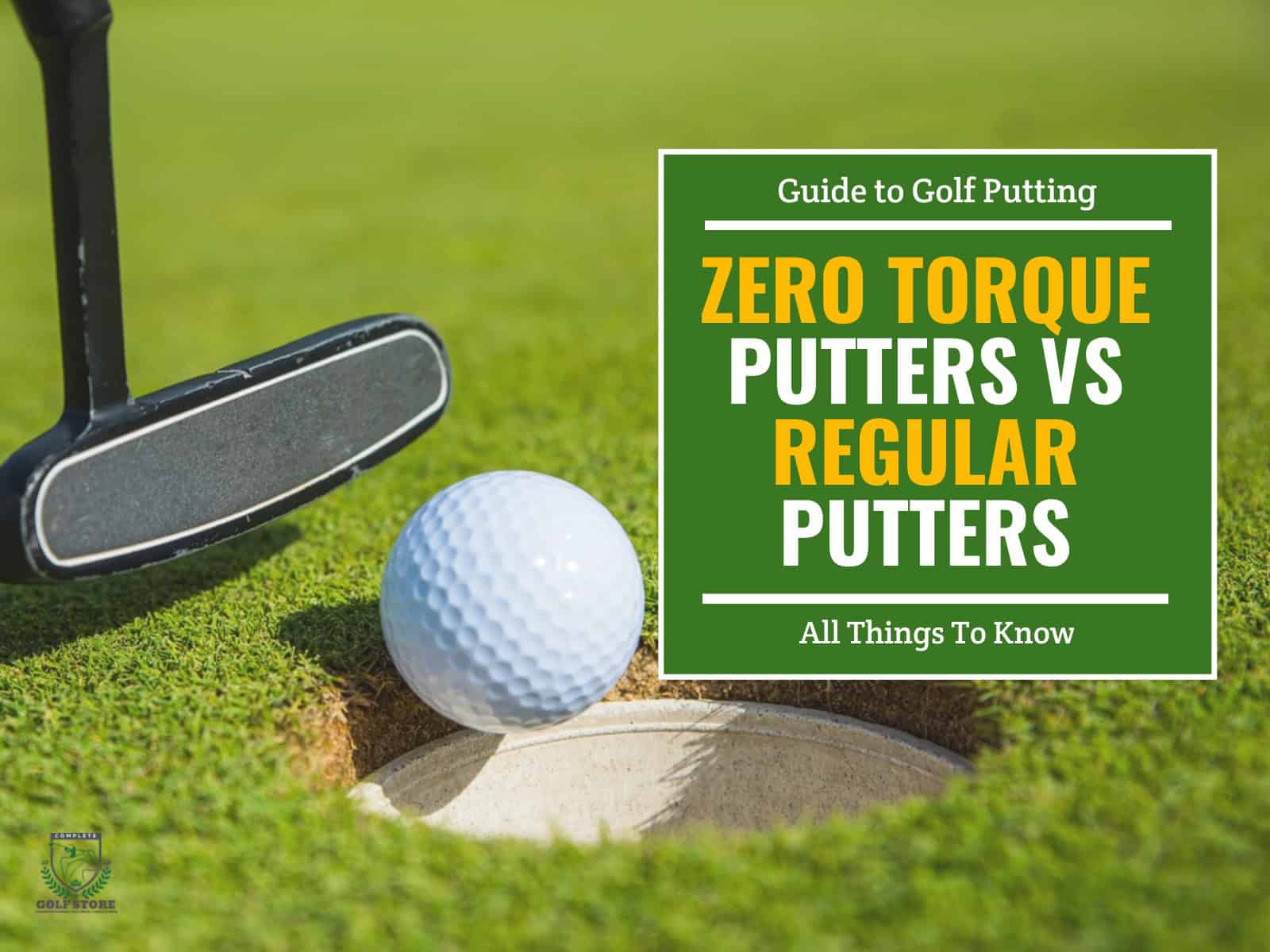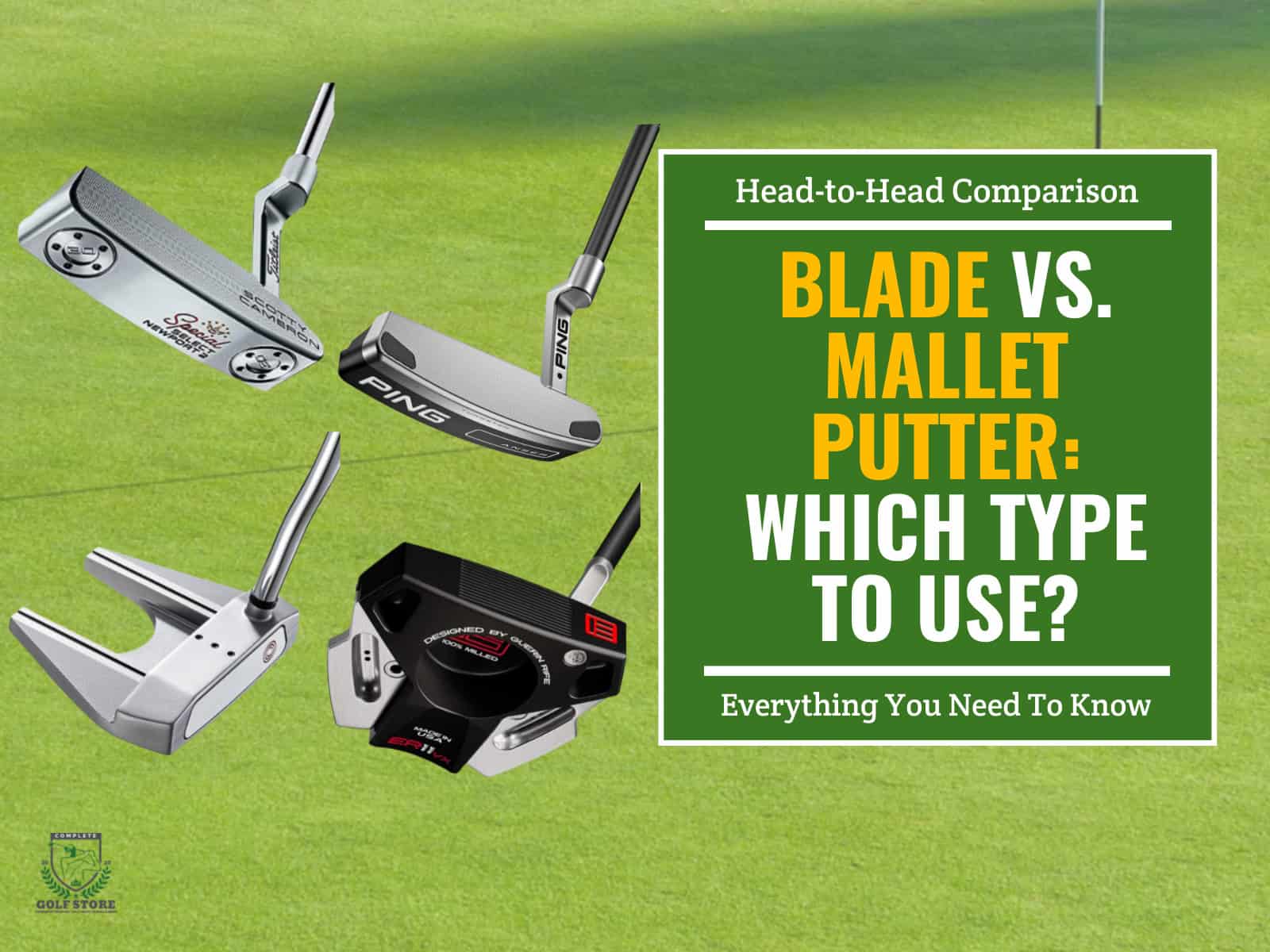Choosing the correct ball is crucial to your game, and selecting the incorrect one can be detrimental. There are numerous golf ball varieties available, and using one versus another will alter the distance, speed, spin, and roll of your shots.
In this article, we’ll explore practice vs. regular golf balls to help you understand the (few) similarities and (many) differences between the two types of golf balls.
What Is A Practice Golf Ball?

Range balls (or driving range balls) are specially designed for use on golf driving ranges. They often have a colored stripe (black, red, or green) and may be labeled “range” or “practice.”
They can be rented in buckets for use in the range, or purchased in bulk for practice outside.
These lighter balls require less space, travel shorter distances, and are less likely to cause damage. That’s why they can be used in smaller areas.
Plastic and foam practice balls have different prices, durability, and ability to replicate a real ball’s flight characteristics.
Types of Practice Balls

There are different types of practice balls to choose from. They may differ in terms of construction, materials, flight characteristics, and use scenarios. let’s explore them one by one.
Foam Balls

A bunch of foam practice balls. Source
Foam practice balls are lightweight and soft, designed to be used in limited space environments such as indoor practice or backyard hitting nets. They are safe to use in confined areas and offer minimal damage potential.
Plastic Balls
These are typically made of hard plastic materials. They are more durable than foam balls and can be used in outdoor settings, such as parks or open fields. Plastic balls often simulate the flight of a real golf ball more closely.
Limited Flight Balls
Limited-flight balls are designed to travel shorter distances compared to standard ones. They are often used on driving ranges with limited space or where safety is a concern. These balls are constructed to provide a similar feel and flight characteristics as regular balls while reducing the distance they can travel.
Hollow Balls
Hollow practice balls are made with a hollow construction, which makes them lightweight and allows them to simulate the feel of hitting a real ball. They are suitable for use in small spaces, such as indoor practice facilities or backyard hitting nets.
Alignment Balls
Alignment practice balls have special markings or patterns on their surface to help golfers visualize and improve their alignment and aim. These balls often feature lines, arrows, or target patterns that aid in developing proper setup and alignment habits.
Please note that practice balls do not necessarily fall into a single category. For instance, you can find a foam practice ball with limited flight. Golfers can choose the type of practice ball that best suits their needs, practice environment, and desired level of simulation to enhance their practice sessions.
How Do Practice Golf Balls Work?
Practice balls work by providing golfers with a means to practice their swings and shots in a safe, controlled and convenient manner.
These balls are often lighter. They also go shorter distances, which means you don’t need as much area for practice and can also recover the balls more simply. Additionally, they are less likely to cause damage to other things they collide with.
Are All Range Balls The Same?

All range balls are not created equal. The quality of range balls varies substantially depending on where you practice and the exclusivity of the golf club where you play. A private country club with high dues will have very good golf balls on the range. Some of these courses will even use something like the excellent Titleist Pro V1 on the driving range.
Naturally, this is a rare occurrence, and you will find that these golf balls perform identically to the standard balls in your bag. At a premium club like this, members want the finest, and the golf staff must deliver.
You may encounter the same range balls at a municipal golf course that has been there for twenty years. These range balls are probably repainted each year, and a few new golf balls are added to the mix.
If you have a few preferred practice locations, you should pay attention to the differences in the range balls available so you can practice in an environment that most closely resembles your game on the golf course.
What Is a Regular Golf Ball?

For standard golf balls, actual performance is paramount. Of course, a good ball cover must be durable enough to resist cutting after a few holes, but apart from that, a conventional golf ball needs to last an eighteen-hole round.
Another more critical component when using a standard golf ball is the feel. People are unlikely to complain about the feel of a range ball because it has no bearing on the golf course, but the feel of a regular ball will matter, and it will make all the difference, particularly in the short game.
However, for winter rounds, choosing the right golf ball that maintains feel and performance in low temperatures is crucial. This is where our guide to the golf balls for cold weather comes in. It provides valuable insights and recommendations to help you select the perfect ball for your winter golfing needs.
Ball manufacturers try to create the best balls for different purposes that will serve all skill levels, from beginners to pros, and cater to their different needs. There are balls specifically designed for distance and straighter flights, others for beginners, seniors, females, ones that glow in the dark, etc.
Practice Golf Balls vs. Regular Golf Balls

The most evident is the difference in performance. The practice golf ball will have a slower speed, will be more durable, and will be less expensive. However, for golfers with slower swing speeds, there are golf balls designed to maximize distance and improve trajectory.
A standard golf ball provides increased speed, more precision, a more accurate spin rate, and a more consistent flight. Let’s cover the differences in more detail.
Cost
The price difference between regular and practice golf balls can vary depending on various factors such as the brand, quality, and quantity purchased.
Regular golf balls, especially those designed for high performance and used in professional play, tend to be more expensive. Prices can range from around $20 to $60 or more for a dozen balls, depending on the brand, model, and features.
Practice balls are generally more affordable. The cost of practice balls can vary depending on the type and quality. Foam practice balls are usually the least expensive, with prices ranging from a few dollars for a pack of a dozen or more. Plastic practice balls or limited flight balls may cost slightly more. However, prices for practice balls generally fall in the lower price range compared to regular balls.
Purpose
Regular golf balls are specifically designed for use during actual rounds of golf. They are engineered to offer optimal performance, distance, spin control, and feel. These balls are constructed with multiple layers and advanced materials to maximize their performance on the course. They provide golfers with accurate feedback, allowing them to assess their shots, make adjustments, and gauge their skill level during competitive play.
On the other hand, practice golf balls are primarily intended for practice sessions and training purposes. They are designed to be more durable and cost-effective than regular golf balls. They are used in driving ranges, practice facilities, or even at home to work on swing mechanics, accuracy, and consistency.
Distance
Regular golf balls are designed to maximize distance and performance. They are constructed with specific materials, aerodynamic dimple designs, and compression levels to achieve optimal distance and trajectory.
Practice balls are intentionally designed to travel shorter distances. They typically have modified flight characteristics to ensure safety in confined practice areas or driving ranges with limited space.
Durability
Practice balls are frequently made from materials like foam or harder plastics, which can withstand the repetitive strikes and impacts that occur during practice. These materials allow practice balls to be more resilient to wear and tear, ensuring they last longer and provide continued usability for extensive practice sessions.
Even though regular balls are made using more advanced technologies and materials, they can’t be nearly as durable as practice balls. They provide better performance and feel, but they are more prone to wear and tear and require more frequent replacements compared to range balls.
Ball Flight
Regular balls are constructed with specific aerodynamic features and compression levels to generate a predictable and consistent ball flight. The flight of a regular golf ball is influenced by factors such as swing speed, angle of attack, and club choice, resulting in the desired carry distance, ball height, and shot shape.
Practice balls are designed to travel shorter distances and have altered trajectories. Foam practice balls, for example, may have a lighter construction that reduces their flight distance while still providing a reasonable simulation of ball flight. A great example is the Almost Golf Practice Balls, which provide closer feel, spin and control levels, albeit with a limited distance of one-third of that of regular balls.
What Kind of Range Balls Do Pros Get at Tournaments?
Do professionals competing in tour events have to use the same battered range balls as the rest of us? Obviously not.
The PGA Tour uses premium golf balls for a purpose. The best golf balls are designed to spin less off the tee, maximize distance on longer shots, maintain control on shorter ones, and spin more around the greens for more control.
Manufacturers transport thousands of golf balls used by their tour players prior to a big tour golf tournament. Although these balls are commonly labeled “practice,” they are identical to the golf balls used by tour professionals during tournament play. For example, Titleist will stamp “practice” on hundreds of Pro V1 and Pro V1x balls and transport them to tournament sites for the pros who use Titleist balls.
Tournament staff and volunteers organize and display these balls according to the brand and model for the tour players.
Final Thoughts
Driving range golf balls are a must-have for anyone who regularly visits a driving range. Allow yourself some leeway if your range balls lack the spin or distance you desire; these are not proper golf balls. Always remember to select practice golf balls that are appropriate for your needs, clubs, budget, and location of play.
We hope our guide could help you understand the differences between practice and regular balls and the characteristics of each type.
If you have more questions or comments, feel free to contact us!
References:
- What is Club Path? TrackMan Golf. https://blog.trackmangolf.com/club-path/






I found a couple of Callaway balls at my local golf course in Toronto. I love hitting Callaway’s, can’t explain why. I can’t afford to buy them so I when I find one I’m thrilled. These 2 balls were stamped ‘practise’.
They look and feel like other Callaway’s that I have. Other than playing with them, is there an easy way to tell if these are designed differently or are they regular golf balls with a stamp?
Thanks for your comment! Since they’re stamped “practice,” it’s most likely they’re just range balls. These are often made a bit differently than retail balls—sometimes with harder covers or slightly altered construction to withstand repeated hits. Without seeing them in person or in a photo, it’s hard to say for sure, but they might still perform similarly to regular Callaways for casual play. If you’re curious, it’s worth asking the staff at your local course—they might know more about where they came from. Either way, sounds like a fun find!